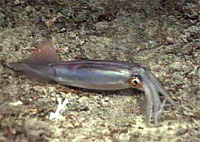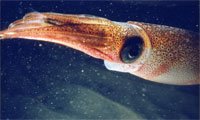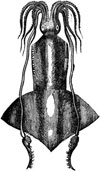|

 Super-blenders: Like all cephalopods, squids are distinguished by having a distinct
head, bilateral symmetry, a mantle, and tentacles with suckers;
squid, like cuttlefish, have eight arms and two tentacles arranged
in pairs. If cut off, the tentacles do not grow back. Squids can
blend in with their surroundings to avoid predators. They also have chromatophores embedded in their skin and the ability to expel ink
if threatened. Being coleoids means that their bony structure is
internalized (in the octopus it is nonexistent); in squid there
is a single flat bone plate buried within the soft tissue structure.
They have a specialized foot called the siphon, or hyponome, that
enables them to move by expelling water under pressure. Squid are
the most skilled of the coleoids at this form of motion. The mouth
of the squid is equipped with a sharp horny beak made of chitin,
used to kill and tear prey into manageable pieces. Captured whales
often have squid beaks in their stomachs, the beak being the only
indigestible part of the squid. The mouth contains the radula (the
rough tongue common to all mollusks except bivalvia and aplacophora). Super-blenders: Like all cephalopods, squids are distinguished by having a distinct
head, bilateral symmetry, a mantle, and tentacles with suckers;
squid, like cuttlefish, have eight arms and two tentacles arranged
in pairs. If cut off, the tentacles do not grow back. Squids can
blend in with their surroundings to avoid predators. They also have chromatophores embedded in their skin and the ability to expel ink
if threatened. Being coleoids means that their bony structure is
internalized (in the octopus it is nonexistent); in squid there
is a single flat bone plate buried within the soft tissue structure.
They have a specialized foot called the siphon, or hyponome, that
enables them to move by expelling water under pressure. Squid are
the most skilled of the coleoids at this form of motion. The mouth
of the squid is equipped with a sharp horny beak made of chitin,
used to kill and tear prey into manageable pieces. Captured whales
often have squid beaks in their stomachs, the beak being the only
indigestible part of the squid. The mouth contains the radula (the
rough tongue common to all mollusks except bivalvia and aplacophora).
Squid have two gills, sometimes called ctenidia, and an extensive
closed circulatory system consisting of a systemic heart and two
gill hearts.

Two tentacles for tea: They are exclusively carnivorous, feeding on fish and other invertebrates.
Squid usually have two elongated tentacles especially for the capture
of food.
The largest eyes of all: The majority of squid are no more than 60 cm in length, but the
giant squid is reportedly up to 20 m in length,  which made it the
largest invertebrate in the world, and it has the largest eyes of
all. Recently, however, an even larger specimen of a poorly understood
species, the Colossal Squid, has been discovered. Giant squids are
featured in literature and folklore, with a strongly frightening
connotation. which made it the
largest invertebrate in the world, and it has the largest eyes of
all. Recently, however, an even larger specimen of a poorly understood
species, the Colossal Squid, has been discovered. Giant squids are
featured in literature and folklore, with a strongly frightening
connotation.
Individual species of squid are found abundantly in certain areas
and provide large catches for fisheries.

Giant squids: A live giant squid was observed for the first time on September
30, 2005, by two  Japanese scientists: Tsunemi Kubodera of the National
Science Museum (of Japan) and Kyoichi Mori of the Ogasawara Whale
Watching Association. From their initial observations, the scientists
concluded that giant squid appear to be more aggressive than previously
thought. A 5.5 meter long tentacle was retrieved (accidentally)
from the creature and DNA tests compared with other giant squid
specimens previously washed up on shore confirmed that indeed they
had observed a live giant squid. The scientists estimated the total
size of the squid to be eight meters. More recently in early 2006
another giant squid, measuring 8.62m (28ft), was caught off the
coast of the Falkland Islands by a trawler. The squid now resides
in a glass tank, filled to the brim with preservative solution,
and is one of 22 million specimens that can be seen as part of the
behind-the-scenes Darwin Centre tour of the Natural History Museum
in London. Japanese scientists: Tsunemi Kubodera of the National
Science Museum (of Japan) and Kyoichi Mori of the Ogasawara Whale
Watching Association. From their initial observations, the scientists
concluded that giant squid appear to be more aggressive than previously
thought. A 5.5 meter long tentacle was retrieved (accidentally)
from the creature and DNA tests compared with other giant squid
specimens previously washed up on shore confirmed that indeed they
had observed a live giant squid. The scientists estimated the total
size of the squid to be eight meters. More recently in early 2006
another giant squid, measuring 8.62m (28ft), was caught off the
coast of the Falkland Islands by a trawler. The squid now resides
in a glass tank, filled to the brim with preservative solution,
and is one of 22 million specimens that can be seen as part of the
behind-the-scenes Darwin Centre tour of the Natural History Museum
in London.
All text is available under the terms
of the GNU Free Documentation License
|